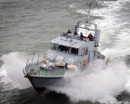Amnectrus
Posts: 80
Joined: 10/22/2015
Status: offline

|
quote:
ORIGINAL: Dimitris
I think this is deliberate. Providing updates to AMRAAM-class weapons requires "tracking" detections, so the target must remain within the radar detect/track arcs. Guiding Sparrow-class weapons requires illumination hits, so the target only needs to remain within the illumination arcs of the radar, which are frequently a bit wider than the ones for detection.
For what it's worth, I looked in the manuals for DCS Flaming Cliffs F-15C, Jane's F-15E, Jane's F/A-18, and in the Falcon 4.0 binder edition manual (I still have my original), and found the following:
The APG-63(V)1 (F-15C), APG-70 (F-15E), and APG-68 (F-16) can point up to +/-60 degrees off the nose, and the APG-73 (F/A-18) can point up to +/-70 degrees. All of the radars have various elevation (bar) settings and radar modes, and although all of the manuals say the target should ideally be centered in the HUD when shooting an AMRAAM, none of them say the radar tracking arc is different from the illumination arc, or that there is any difference in allowable angle off the nose for AMRAAMs vs Sparrows. The Jane's F-15E manual specifically says a lock can be maintained out to 60 degrees off boresight (page 2.13), and that a special indicator appears when the target gets to 50 degrees, to let you know it's getting close to breaking the lock. And the Jane's F/A-18 manual says the TWS search area can be anywhere within the radar's gimbal limits.
All four radars allow launching multiple AMRAAMs against multiple targets using Track-While-Scan (TWS) mode. According to the manuals, the APG-68 TWS scans a rectangle either +/-10 deg 4-bar, or +/-25 deg 3-bar, and says a bar is 2.2 deg. The APG-70 has 3 TWS settings: +/-60 deg 2-bar, +/-30 deg 4-bar, or +/- 15 deg 6-bar, but exact bar angle isn't given. The APG-73 has 7 TWS settings: +/-20 deg 2/4/6-bar, +/-40 deg 2/4-bar, +/-60 deg 2-bar, and +/-80 deg 2-bar. The DCS F-15C unfortunately doesn't have details on the TWS scan sizes. In all cases, the TWS mode radar cone can point anywhere within the radar's field of view (up to +/-60 or 70 deg off the nose), but the cone is limited in width and elevation because it needs to physically point the radar dish at the targets more often to keep their tracks updated.
(Interestingly, none of the manuals seem to mention "cranking" after shooting to minimize closure, and "notching" is only mentioned in the DCS F-15C manual, though it does cover it in a fair amount of detail. It's also worth noting that Sparrows in each manual are listed as requiring single-target-track (STT) mode; they can't be guided in TWS mode at all.)
So if the information in the manuals is correct, I guess in my unsolicited layman's opinion I feel like a good way to model active-radar missiles would be as follows (assuming the engine supports this):
* Current radar search/detect behavior and arc when no missiles are in the air is unchanged.
* When a missile is launched against a target, allow the aircraft to maneuver similar to how SARH missiles are modeled: missile keeps datalink as long as the target doesn't go more than 60 deg off nose.
* While a missile is being guided, the launching airplane should also track other enemy targets that are within a 30 degree cone centered on the first target. Launching other missiles at those targets is allowed as long as other launch parameters are met.
* As missiles impact or miss, the center of the 30 deg cone should shift to the other targets in the order they were launched on. (Or maybe the cone could be centered on the average center position of all the targets.)
* Missiles with CEC would work as they currently do, with no limitations on radar arcs.
* AESA radars would be able to guide missiles on targets anywhere within their full field of view (usually +/-60 deg), as they can currently. (I'm not sure if that's actually the case IRL, but from what I know, AESA radars should be able to effectively track-while-scan all their targets all the time, since they can point their radar beam nearly instantly.)
All this would mean that SARH-armed planes would not be at quite as big a disadvantage against active-radar-armed planes as they are now, especially if they're spread out and not in close formation. Active-radar-armed planes would still be able to launch against multiple targets, but only if they're in clusters. However, they would be able to "crank" in the same way that SARH-armed planes do, and they would still have the advantage of being able to break contact if needed to evade and their missiles would still have a chance to guide on their own. This would also mean planes with AESA radars would have a significant advantage in being able to simultaneously engage widely separated targets.
|
 Printable Version
Printable Version










 New Messages
New Messages No New Messages
No New Messages Hot Topic w/ New Messages
Hot Topic w/ New Messages Hot Topic w/o New Messages
Hot Topic w/o New Messages Locked w/ New Messages
Locked w/ New Messages Locked w/o New Messages
Locked w/o New Messages Post New Thread
Post New Thread